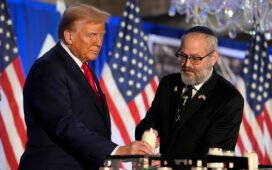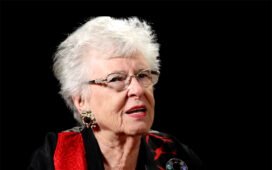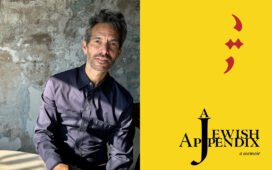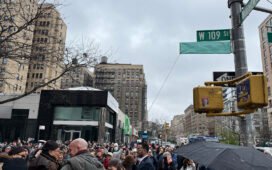(RNS) — I don’t typically get emotional when reading history books, but I did with Matthew L. Harris’ groundbreaking “Second-Class Saints: Black Mormons and the Struggle for Racial Equality.” It’s a gripping, and often heartbreaking, read.
The book carefully details the church’s ban on ordaining Black men to the priesthood and prohibiting Black men and women from temple ordinances, including interracial marriages. The ban, not rescinded until 1978, defined much of the 20th-century history of The Church of Jesus Christ of Latter-day Saints. Because Harris had access to letters, diaries and meeting minutes from the Quorum of the Twelve — some of which he was the first historian to see — many stories in the book have never been told before.
One of the main themes of the book was that the Brethren disagreed quite sharply on the racial priesthood-temple ban and what to do about it. Harris spoke to me about how most LDS leaders wanted to preserve the ban while others fought to lift it — even at great personal cost. This Religion News Service interview has been edited for length and clarity.
The beginnings of desegregation in the U.S. in the 1950s catalyzed a kind of counterreaction in the church, like with Mark E. Petersen’s response to Brown v. Board of Education in 1954. Walk us through that story.
The Brown case was announced in June of 1954. The winds had been blowing toward racial equality for a long time, and the Brethren were worried about how it would affect the church’s properties that were segregated and various establishments in Salt Lake City. The Hotel Utah was segregated, for example. In Utah, it was de facto, rather than de jure segregation, but it was segregation all the same.
Most particularly, they were worried that the movement toward racial equality would compromise the church’s teachings on interracial marriage.
It comes up again and again in the book that interracial marriage was a huge fear of theirs.

Matthew L. Harris. (Photo by Jeanette Baysinger)
Exactly. They feared Black sexuality, much as the Protestant South did. So when the Brown case came out, you see different responses from the leaders. President David O. McKay supported the Brown decision but told his colleagues: “Let’s not talk about this publicly. And any of our politicians in Washington, D.C. — including Arthur Watkins [a Utah senator] — let’s instruct them not to be on any committees that deal with race.” They didn’t want attention called to the church’s race doctrine, so they tried to avoid the spotlight. McKay’s response was to just remain silent.
J. Reuben Clark, his counselor, said: “Let’s talk about it openly and acknowledge it. It’s OK that we can embrace racial equality a little bit.” But he didn’t state what that meant. Did that mean interracial marriage? No. Did that mean striking down discrimination laws in housing and in employment? No. Did it mean ending segregation in Salt Lake? He was not specific. But he said we should just tell people we’re OK with racial equality as a general concept.
The third response was from Mark E. Petersen, and it was very aggressive. In August of 1954, during a series of workshops from the general authorities at Brigham Young University, Petersen decided that he would address the race issue. CES [Church Educational System] teachers came from around the country to attend these seminars. Hugh Nibley was there, Sidney Sperry and Paul Dunn, the future general authority, along with George Boyd, Spencer Kimball’s brother-in-law and Lowell Bennion from the University of Utah Institute.
Petersen gave an aggressive address and the main theme was interracial marriage. He told the teachers that he favored segregation, appealing to the Bible to justify it. He quoted Joseph Fielding Smith as well, who was the church’s doctrinal authority, and was also at the workshops with Petersen. When Petersen finished speaking, the educators had questions, all off the record. Nothing was supposed to be published, not even the transcript. Petersen told them that whatever you ask here today will remain between us. So they asked him every question that they would probably never ask in a public setting, such as: Is it true that a Black person’s skin will turn white when they embrace the gospel? And Joseph Fielding Smith told them, “We have actual examples where this has happened.”
Lowell Bennion, who was a liberal in the Church Educational System, asked Elder Petersen if he felt good about teaching that the ban was the result of choices Black people had made in the preexistence. How is that good theology? Aren’t we supposed to be punished for our own transgressions and not for those of our ancestors? If Black people did something wrong in the premortal life, can they repent? Because what you’re saying is they can’t repent. Bennion was really striking at the heart of this theology and pointing out the contradictions that the Brethren, frankly, had never really grappled with.
When I saw this transcript that was supposed to remain private, it really opened up a story about what these guys were thinking, and what they could say in private. William Berrett, Ernest Wilkinson’s vice president, was at the meeting and took notes, and I found the transcript in his papers at BYU. The educators were getting unvarnished answers from these two apostles who were, frankly, the two biggest hard-liners in the post-World War II era.
The story also shows something we see throughout the history: There’s a “minority report.” There always seems to be at least one person, whether it’s Lowell Bennion or Hugh B. Brown of the First Presidency, who is trying very hard to steer things in a more just direction. And then that person keeps getting squashed.
Yes. The Brethren were not always on the same page. They had different views, thoughts and life experiences. And one thing that’s really shocking for some Latter-day Saints to hear is the extent to which some of the leaders would break ranks and make their views known.
Hugh B. Brown is a great example. He certainly made his views known in private about the need to lift the ban. He said it was incompatible with Scripture; that there was nothing in church records that tied the ban to the founding prophet, Joseph Smith; that it was a policy, not a doctrine. And if it was a policy, that meant it could be lifted at the president’s discretion.
But when Brown couldn’t convince his fellow Brethren of his views, he did something that’s wholly unimaginable by the standards of either then or today: He spoke to the press. On at least three different occasions, he revealed sensitive discussions to the press, trying to put pressure on the church to lift the ban and to support civil rights.
His colleagues rebuked him each time he did this. That tells you how strongly he felt, that he was willing to risk so much to speak out. It wasn’t surprising that in January of 1970, when President McKay died and they re-formed the First Presidency, Hugh Brown was dropped.
So Hugh B. Brown pays a serious price. There’s a powerful moment in the book when you talk about how he’s essentially strong-armed into signing a document that he doesn’t want to sign, to demonstrate the united front that the Brethren want to show.
Harold B. Lee called Brown in, and he said: “You’ve been talking to the press and saying that we’re going to lift the ban. We’re not going to lift the ban. In fact, you’re creating confusion among people, particularly our own people. So we need to produce a statement and you’re going to sign it.”
I just want that to sink in for a moment. This is a senior apostle telling a member of the First Presidency that he’s going to sign a statement that is contrary to his wishes. Brown refused to sign it until they added a statement indicating that the church supported civil rights.
But even that concession didn’t make him happy. So Brown gave another interview a couple of weeks after the statement was drafted and told a journalist that church leaders were going to lift the ban. He had nothing to base this on because his colleagues didn’t support it, or at least most of them didn’t. Spencer Kimball did, but the majority didn’t because they feared Harold Lee, who was the most influential apostle in the 1950s and ’60s.
Brown did everything he could to apply pressure to lift the ban, but some of the senior apostles interpreted Scripture in a rigid way that wasn’t compatible with racial inclusion. Brown thought that the ban was just a policy and could be lifted at the president’s discretion, whereas the hard-liners, as I call them in the book, argued that it required a revelation. The Doctrine and Covenants talks about the process to produce an institutional revelation. There has to be a consensus among the top 15 leaders — the First Presidency and the Quorum of the Twelve.
You write in the book that such a consensus doesn’t happen until after Brown’s death, when Spencer W. Kimball decided it should — and that Kimball had to convince the other Brethren before he announced the revelation in 1978.
When Spencer Kimball was praying in the temple in 1977 and 1978, he wasn’t asking God, “Do I need to lift the ban?” Rather, he asked, “God, help me get my colleagues to see the wisdom in this.” That’s a fundamental difference the church has not told very well. The story has been told in the most simplistic way — that the prophet showed up in the temple on June 1, nobody saw it coming, and God told him to lift the ban. But in the book, I go into detail about how Kimball went to great lengths to convince the apostles that lifting the ban was in the best interests of the church, especially as leaders tried to spread the gospel globally.
Related content:
Mormons know how the church sanctioned racial exclusion. That policy has a paper trail.
Mormon leader Brad Wilcox’s apology for racist remarks does not go far enough















